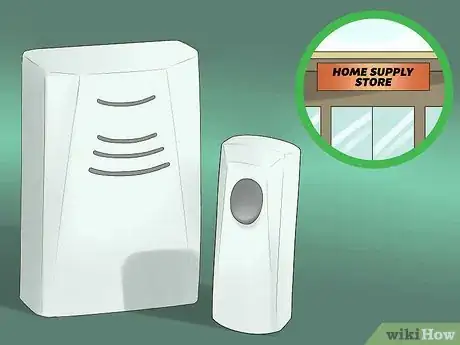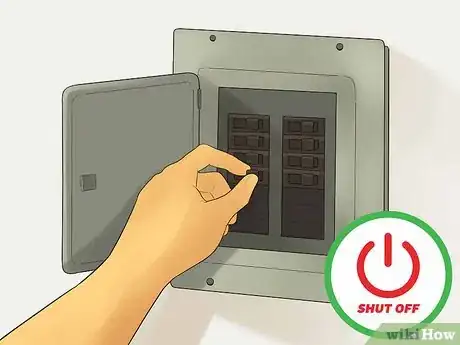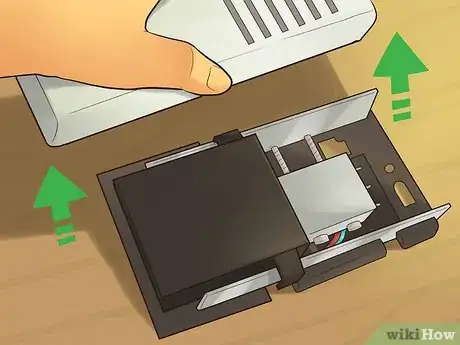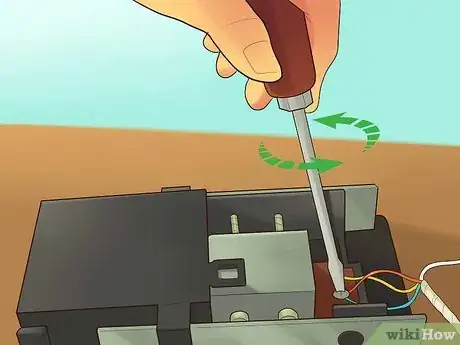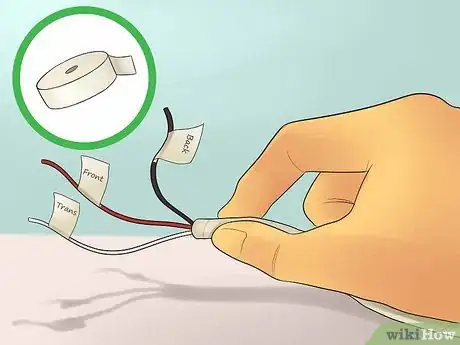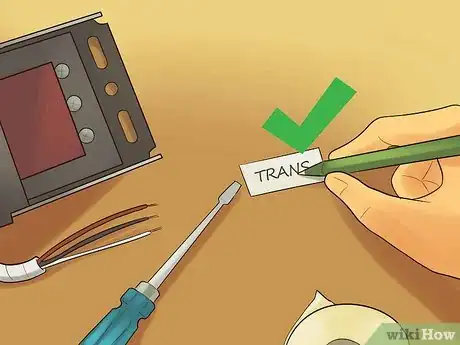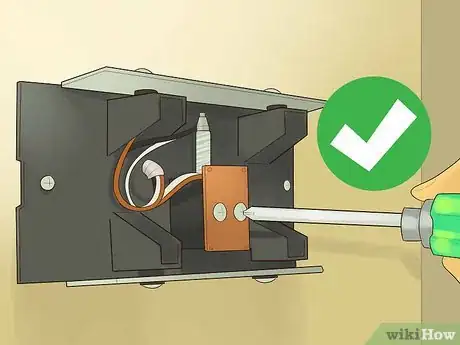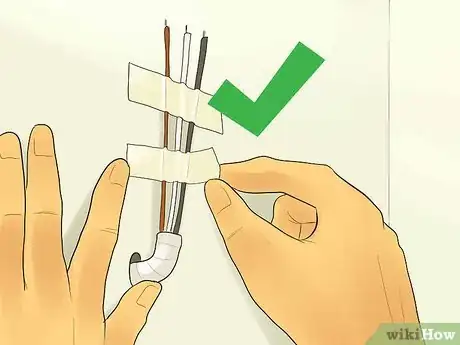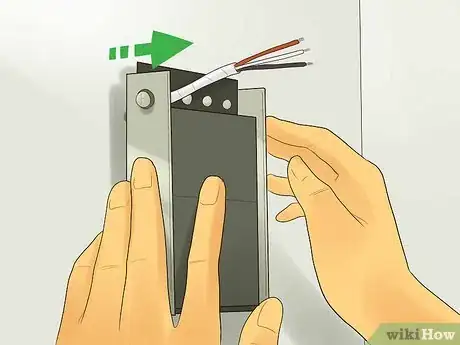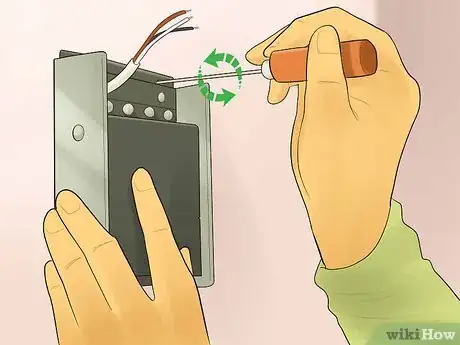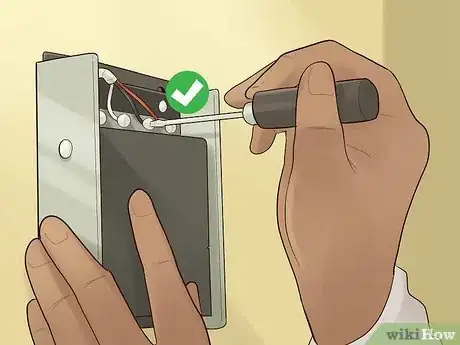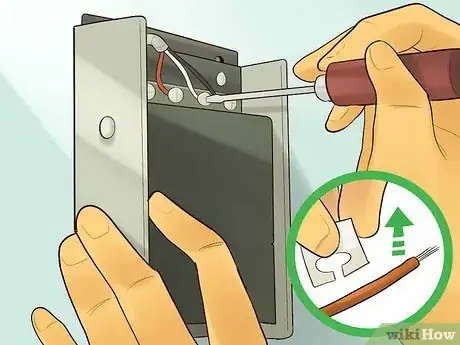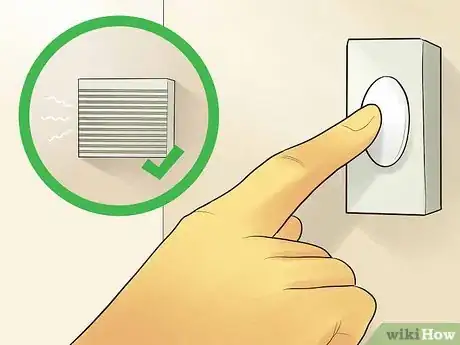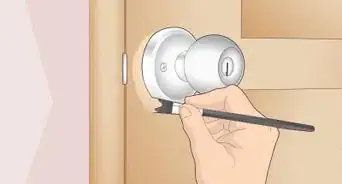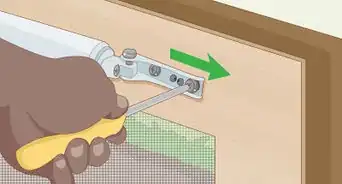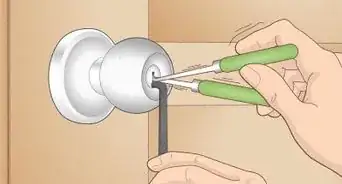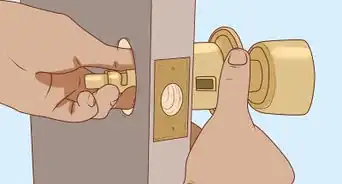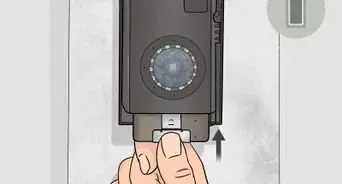This article was co-authored by Jacob Pischer. Jacob Pischer is a Home Improvement Specialist and the Owner of Helpful Badger, a home repair service in Portland, OR. With over four years of experience, Jacob specializes in a variety of handyman services including pressure washing, cleaning gutters, repairing drywall, fixing leaky plumbing fixtures, and repairing broken doors. Jacob studied at Madison Area Technical College and has a background in real estate investment.
There are 8 references cited in this article, which can be found at the bottom of the page.
This article has been viewed 131,152 times.
Each doorbell chime box comes with a unique chime sound already built in. If the chime no longer functions or you’d like to swap it out for a new sound, you’ll need to replace the chime system inside the chime box. This is a quick project that can be done in about 30 minutes: simply unscrew the old chime box from the wall and disconnect the wires, then re-attach them to the new chime box and screw it back on the wall. Be sure to turn off the electricity before you begin.
Steps
Removing the Chime Cover
-
1Buy a new doorbell chime. You should be able to find one at your local hardware store, or at any home supply store. Doorbell chime boxes are rectangle-shaped boxes, roughly 6 inches by 4 inches (15 cm by 10 cm). The specific chime sound of each doorbell—e.g. a traditional “ding dong” or a novelty ring—should be marked clearly on the box.
- Ask the sales staff for help if you like; they’ll be able to recommend which doorbell brand they prefer.
-
2Shut off power to the circuit that the doorbell is wired to. You’ll need to find the circuit breaker box in your house or apartment. Breaker boxes are often located in the pantry or kitchen (in apartments) or in the basement or garage (in houses). Then, find the specific labeled breaker that controls power to the room that your doorbell chime box is located in.[1]
- Doorbell chime boxes are usually located in well-trafficked areas of a house. The chime will be located on the wall, typically in the living room. Also check in the dining room or front hallway if you’re unsure of the box’s location.
- For example, if the chime box is located in the living room, you’ll flip “off” the breaker labeled “Living Room.”
Advertisement -
3Remove the cover from the chime. To remove the cover, simply lift up from the bottom. The chime-box cover will lift upwards, and you can then lift the top part of the box away from the metal chime unit.[2]
- Set the cover somewhere nearby, like on the living room sofa or a chair.
Removing the Wires and Screws
-
1Loosen the screw holding the “Front” wire in place. Once you’ve removed the plastic chime cover, you’ll see a small panel with two (or three) screws on it, each pinning down a lead wire. The screws will be labeled “Front,” (for the front doorbell), “Trans” (connected to the transformer), and “Rear” or “Back,” if your house has a doorbell at the back door. Use a screwdriver to first loosen the screw labeled “Front.”[3]
- These screws could either be regular or Phillips head. You’ll have to inspect your specific chime box to find out which type of screwdriver you need to loosen the screws.
-
2Label and remove the front lead wire. After you’ve loosened the “Front” screw, unhook the piece of wire from behind it. To avoid confusion, make a note which screw terminal it is connected to. Take a small piece of masking tape, and write the word “Front” on the strip, and then fasten the tape around the lead wire.
- Alternately, if the “Front,” “Trans,” and “Rear” wires are all different colors, you could remember which is which by jotting down which color was attached to which screw.[4]
- For example, write: “Trans = white wire,” “Front = red white,” “Back = black wire,” or whatever colors your specific wires may be.
-
3Repeat with the other wire(s). After you’ve removed the lead wire connecting to the “Front” screw and labeled the wire accordingly, repeat the process with the “Trans” and “Back” or “Rear” screws. Loosen the screw and remove the wires, then use a piece of masking tape (or a note on paper) to label the wire “Trans” or “Rear.”[5]
- Not all doorbells have a bell at both the front and back doors. If yours doesn’t have a “Back” wire and screw, just remove and label the “Trans” wire.
-
4Remove the chime from the wall. Now that you’ve disconnected and labeled the wires, you can use the same screwdriver to remove the two screws that are holding the metal chime plate to the wall. Pull the chime gently away from the wall, taking care to thread the loose wires out through the back of the chime.[6]
- Set the screws in the back of the plastic chime box that you removed earlier. This way, you’ll know where they are.
- Avoid jerking on the wires or pulling on the chime too quickly, as this could damage or disconnect the wires inside the wall.
-
5Tape the wires to the wall. Once you’ve removed the chime box from the wall, the two (or three) wires could easily slip back behind your drywall. To prevent this, use a piece of masking tape to secure all three wires to the wall. Tape them down securely, about 4 inches (10 cm) from the edge of the hole that the chime box came out of.
- If the wires do slip behind your wall, they’ll be very difficult to extract.
Installing the New Chime
-
1Thread the wires through the back of the new chime. The new doorbell chime should be structured the same as the chime that you just removed. Remove the wires that you’ve taped to your wall, and feed them through the open hole in the chime that you’re installing.[7]
- Until the wires are firmly secured under their respective screws, you’ll need to keep a finger or two on them so they don’t slip behind the wall.
-
2Mount the new chime to the wall with screws. Pick up the screws from where you set them earlier, and re-attach the new chime to the wall.[8]
-
3Connect the wire labeled “Front.” Similarly to the old doorbell chime, the new chime should have a screw terminal labeled “Front.” Loop the exposed copper portion of the wire labeled “Front” over the corresponding screw and give it a full clockwise twist around the screw.[9]
- Once the exposed copper wire is wrapped around the screw, tighten the screw until the wire is held firmly in place. Then remove the piece of tape from around the wire.
- Do not wrap the insulation-covered portion of the wire around the screw.
-
4Repeat with the wire(s) labeled “Back” and “Trans.” Once the “Front” wire is connected, follow the same procedure to reconnect the other wire(s) to their respectively labeled screws. Tighten each screw so that the exposed copper portion of the wire is held in place, but not to the point that it’s being crushed.[10]
- After connecting the wires to their respective screws, remember to remove the masking tape that you attached earlier.
-
5Turn the breaker back on and test-ring the doorbell. You’ll need to return to the circuit breaker box, and flip the “Living Room” breaker back to the “On” position. Then walk to your front door (and back door, if applicable) and press the doorbell. If the bell(s) sound, you’ve installed the chime correctly.[11]
- If the doorbell doesn’t work, check to make sure that the power is back on in the rest of the living room (or whichever room the chime box is located in). Then, make sure that the wires each only touch a single screw, and are firmly connected around the screws’ bases.
- Test the conductivity of the wires by either using a battery tester or meter reader, to ensure that everything is conducive all the way through before placing the plastic cover over the chime.
- If the doorbell works properly, you can place the plastic cover back over the chime.
Community Q&A
-
QuestionWhat if my old chime did not have a rear push wire?
 Community AnswerThat just means that you don't have a connection for a doorbell at your back door. You'll need to find a new chime box that also only has a "Front" and "Trans" screw.
Community AnswerThat just means that you don't have a connection for a doorbell at your back door. You'll need to find a new chime box that also only has a "Front" and "Trans" screw. -
QuestionCan I replace only the part that strikes the chime?
 Community AnswerIt might be worth asking the sales staff at your local hardware store. It's unlikely that they'll have only the striker; you'll probably need to replace the entire chime.
Community AnswerIt might be worth asking the sales staff at your local hardware store. It's unlikely that they'll have only the striker; you'll probably need to replace the entire chime. -
QuestionWhat if chime doesn't stop ringing? What is the problem?
 Community AnswerThere may be dust in the chime, or a wiring problem. Turn off power, and remove the chime box. Clean the electrical connections with a Q-tip and rubbing alcohol, and see if the ringing stops.
Community AnswerThere may be dust in the chime, or a wiring problem. Turn off power, and remove the chime box. Clean the electrical connections with a Q-tip and rubbing alcohol, and see if the ringing stops.
Things You’ll Need
- Screwdriver(s)
- Masking Tape
- Pen
- Doorbell Chime
- Screws
References
- ↑ https://www.youtube.com/watch?v=XdfTGLmYm0M&feature=youtu.be&t=40s
- ↑ https://www.youtube.com/watch?v=OAW39h2kql4&feature=youtu.be&t=23s
- ↑ https://www.youtube.com/watch?v=OAW39h2kql4&feature=youtu.be&t=45s
- ↑ https://www.youtube.com/watch?v=XdfTGLmYm0M&feature=youtu.be&t=2m30s
- ↑ http://www.dummies.com/home-garden/home-improvement/electrical-wiring/how-to-change-the-chimes-in-your-doorbell/
- ↑ https://www.youtube.com/watch?v=OAW39h2kql4&feature=youtu.be&t=30s
- ↑ http://www.dummies.com/home-garden/home-improvement/electrical-wiring/how-to-change-the-chimes-in-your-doorbell/
- ↑ https://www.youtube.com/watch?v=OAW39h2kql4&feature=youtu.be&t=1m5s
- ↑ http://www.dummies.com/home-garden/home-improvement/electrical-wiring/how-to-change-the-chimes-in-your-doorbell/
